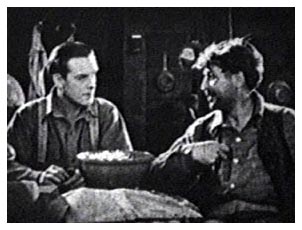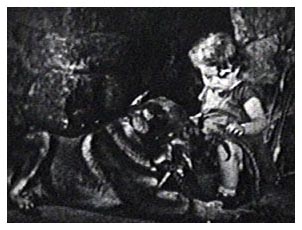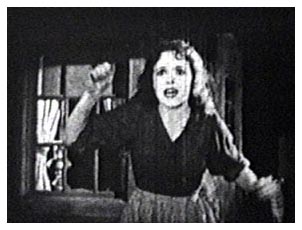

Produced Warner Brothers
CAST: Rin Tin Tin (himself), John Harron (John Martin), June Marlowe (Helen Martin), Mary Louise Miller (Baby Louise), Gayne Whitman (Bart Hawkins), Heinie Conklin (Aitkens), also with Don Alvarado.
John Martin, along with his sheep dog Rin Tin Tin, tend
their sheep herd every day, and Rinty watches over them at night.
Neighboring sheepherder Bart Hawkins is finding sheep killed
by an animal on his ranch and can't figure out why nothing is
happening to Martin's sheep. The only thing he can conclude is
that Rinty is killing his sheep, because a sheep dog will never
kill in his own herd. Hawkins, the sheriff and Hawkins' men go
to Martin's cabin and confront him with the charge. Martin says
Rinty never leaves his herd, and he will prove it. Unfortunately,
as the men head out  to the herd, Rinty
has seen a condor flying overhead and scaring the sheep. Rinty
gives chase which leads him through Hawkins' herd and up a mountain.
The men look for Rinty all night and can't find him. However,
when they find another dead lamb and Rinty's collar on Hawkins'
property, the sheriff orders Martin to kill the dog. Martin tries
to carry out the order and can't make himself do it, so he has
to hide Rinty from the suspicious Hawkins who doesn't believe
the dog has been killed. One day while Martin is tending his
herd, Hawkins goes to the cabin determined to find the dog and
kill him. Martin's wife, Helen, and their baby are there, and
Hawkins forces himself into the house. When he eventually finds
Rinty, Helen fights him, but he locks her in a closet. Although
tied to a rope, Rinty fights Hawkins who eventually falls and
hits his head on the hearth knocking himself out. The baby wanders
outside where the condor picks her up and carries her away. Helen
is locked in a closet and sees this horror through a small window.
Rinty is desperately trying to break the rope so he can save
the child. In the meantime, the sheriff and Hawkins' men go to
Martin to tell him they saw the condor and know Rinty did not
kill the sheep. However, the men tell him that Hawkins has gone
to the cabin to kill Rinty, so they also rush to rescue the dog
not knowing the terrible situation that has occurred.
to the herd, Rinty
has seen a condor flying overhead and scaring the sheep. Rinty
gives chase which leads him through Hawkins' herd and up a mountain.
The men look for Rinty all night and can't find him. However,
when they find another dead lamb and Rinty's collar on Hawkins'
property, the sheriff orders Martin to kill the dog. Martin tries
to carry out the order and can't make himself do it, so he has
to hide Rinty from the suspicious Hawkins who doesn't believe
the dog has been killed. One day while Martin is tending his
herd, Hawkins goes to the cabin determined to find the dog and
kill him. Martin's wife, Helen, and their baby are there, and
Hawkins forces himself into the house. When he eventually finds
Rinty, Helen fights him, but he locks her in a closet. Although
tied to a rope, Rinty fights Hawkins who eventually falls and
hits his head on the hearth knocking himself out. The baby wanders
outside where the condor picks her up and carries her away. Helen
is locked in a closet and sees this horror through a small window.
Rinty is desperately trying to break the rope so he can save
the child. In the meantime, the sheriff and Hawkins' men go to
Martin to tell him they saw the condor and know Rinty did not
kill the sheep. However, the men tell him that Hawkins has gone
to the cabin to kill Rinty, so they also rush to rescue the dog
not knowing the terrible situation that has occurred.
See this film! That's the best way I know to start this commentary. It's a non-stop action thriller from beginning to end that doesn't slow down, doesn't have any lulls in the story, and will keep you on the edge of your seat for the entire 62 minutes.
This movie can be divided into four segments, each one maintaining the tension and suspense of the story, with the final segment rivaling the conclusion of many high budget pictures from that era.
After only a few minutes of introducing John Martin along with some magnificent shots of Rin Tin Tin and some beautiful countryside, the first segment introduces us to the "villain" in the form of Bart Hawkins, a neighboring sheep rancher who is quick to blame his murdered sheep on Rinty. Right away, the suspense picks up momentum, and that evening Hawkins, two of his men, and the sheriff go to Martin's house to confront him. Martin offers to take them to the herd to prove that Rinty never leaves his sheep. However, we have been shown a large condor (the title says his wing spread is 12 feet) who has frightened the sheep. Rinty leaps down from his tree to follow the condor. Obviously the men can't find Rinty, so Martin is helpless to defend his dog even though Rinty is trying to rid the countryside of a menace. When another sheep is killed that night and Rinty's collar is found on Hawkins' property, Martin is ordered by the sheriff to shoot the dog.
This only sets us up for the next segment which, although it may have less action, is no less exciting. Martin, his wife, Helen, and their baby are sitting at the table eating the next morning when Rinty, who is limping from an injury chasing the condor, opens the door and comes in. Martin looks over his shoulder with disappointment on his face believing Rinty has, indeed, killed those sheep. When Rinty lays his chin on Martin's arm, Martin ignores him. He then goes to Helen and lays his chin on her arm. Rinty then places his paws on the table and his snout on the table's edge with pitiful eyes looking back and forth at his master and mistress. Finally, he goes over to the baby and lays his head in front of her. She pats him on the head. The implication is clear. The dog is harmless, even around a small child.
Martin ties a rope around the dog's neck and takes him outside
to shoot him. Helen lays her head on the table and sobs. Martin
ties the dog next to the house and is agonizing over the deed.
In the meantime, the baby gets down from her high chair and ambles
outside. Just as the child comes around the corner to pet the
dog, Martin turns his head, closes his eyes, and fires the gun!
In spite of the fact that we know the child can't be killed in
this manner, it is no less  thrilling. By the
way, Martin missed Rinty, too.
thrilling. By the
way, Martin missed Rinty, too.
In segment three, Hawkins comes to the house, and the Martins must hide Rinty in the bedroom. Without going into the detail of this scene, it raises the viewer's anxiety level significantly as Hawkins sits at the table eating popcorn with Rinty's collar right there under a newspaper, and then hears a noise in the bedroom and goes in there looking for Rinty.
Then segment four, which brings about the conclusion, but is also the longest and the most exciting, has Hawkins coming to the cabin while Martin is tending his sheep. Helen has tied Rinty to a hook in the floor in front of the fireplace so he can play with the baby. When she sees Hawkins coming, she tries to untie Rinty, but can't get the knot loose. She lifts a trap door in the floor and puts Rinty under the house, although the rope can still be seen going from the trap door to the hook in the floor. Helen throws a rag over the rope. Hawkins comes in demanding to know where the dog is. He continues to look around, and Helen fakes feeling faint. Hawkins gets her a drink of water. As he gives her the water, the baby brings the rag over exposing the rope. Eventually, Hawkins sees the rope and gets his gun to shoot Rinty. Without giving away the rest of the story, it must be noted that the viewer gets no short shrift on excitement from this point on as Helen is locked in a closet, Rinty fights Hawkins, the baby wanders outside and is taken away by the condor, and Martin, the sheriff and Hawkins men rush to the house to keep Hawkins from killing Rinty.
It is expected that we will be given ample opportunity to see how "human" the dog hero is, along with sympathetic and pitiful scenes meant to bring tears to the children as the dog hero suffers injury or gazes helplessly to some human who either hates animals or can't understand what the animal wants. There are some touches of these things in "The Night Cry," but credit must be given to the writers and director Herman C. Raymaker because they have allowed the story to be the thing that mesmerizes the viewer, not dog tricks or maudlin sentiment. This story is solid and packs an ample supply of thrills and excitement into its relatively short time frame.
It is necessary for the viewer to suspend belief to some
degree and forgive some minor incidents of "literary license."
For Rin Tin Tin to survive a fall from a mountain while the condor
is killed by the same fall, requires a little imagination, that
shouldn't be too much to expect as we know that our "hero"
must come out OK in the end. And although it is entirely possible
for a child of this size to be taken away by a bird of this size,
we can't help but wonder how all of this could happen without
the child sustaining the slightest injury. Also, the director
wisely kept the shots of the condor with the baby to a bare minimum,
and actually we don't get enough time, or the distance is too
great, to see anything to criticize as unreal. There are obviously
some staged sets in this movie, but they are well done and do
 not detract from the enjoyment.
not detract from the enjoyment.
Although these are some minor concessions, we must also give praise to the scenes which have the baby and the condor within feet of each other. I'm not sure how this was managed, particularly in a safe manner, but they are well done and keep the viewer gripping the arms of the recliner tightly. There is one scene where Rinty and Hawkins' dog, Pete, get in a fight. Pete is obviously a well-trained dog, too, and it's a little disturbing to see the dogs fight, but we have to trust that these were handled in a manner where the animals were not hurt, or at least we hope so.
Although the New York Times was traditionally reserved in giving praise, the reviewer said, "This picture, which is one of the best dog stories produced for the screen, not only thrilled the youngsters but also their mothers." For acting, he gave the most praise to baby Marie Louise Miller, although he did say Harron's and Marlowe's performances were "efficient," about the best praise an actor could get from the Times.
Variety said, "This is an out and out thrill picture. . . " However, the reviewer says he prefers an earlier version of this story that starred Strongheart. "For thrills, the picture is better than the majority of dog star productions that have been shown . . ." Echoing the Times reviewer, Variety said, "John Harron and June Marlowe, featured with the dog, handle their roles nicely, but little Marie Louise, the baby, is about the best little actress in the picture."
Picture Play Magazine was less impressed saying the movie was " . . . another not-so-good story, depending on its leading character." Motion Picture Magazine said it was "an out and out thriller," adding, "The picture is punctuated with thrills most of the way -- and it is shot against atmospheric backgrounds."
John (sometimes "Johnny" or "Johnnie")
Harron was Bobby Harron's (who died of an accidental self-inflicted
gunshot wound Sept. 1, 1920) younger brother and was given his
first big chance by Mary Pickford in her 1921 feature "Through
the Back Door." He was quoted as saying he had a small part
in only one other film for Ince which he dismissed with, "Didn't
amount to anything," but there seems to be no record of this.
The only film to his credit prior to the Pickford film is Griffith's
"Hearts of the World" in which he had a small part as
an extra. According to a 1921 Motion Picture Classic article
which was written while "Through the Back Door" was
in production, Louise Fazenda dragged Harron into the Classic's
office touting what a great star the kid was going to be. It
was a few more weeks until the bashful Harron actually did the
interview. Although he worked steadily with almost 160 films
between 1921 and 1939, he does not have a memorable role to his
credit. Unfortunately, he died at age 36 in 1939 from a heart
 attack.
attack.
June Marlowe was born Gisela Goetten in St. Cloud, Minnesota, on November 6, 1903, and could speak both German and English equally well. She supposedly was discovered in a school play at Hollywood High by Mal St. Clair who gave her a small part in the "Fighting Blood" series. This led to a part in "When a Man's a Man" (1924) for Sol Lesser in which she got good reviews and reportedly outshined leading lady Marguerite De La Motte. Then she was brought to the attention of Jack Warner and made the first of several films with Rin Tin Tin, "Find Your Man" (1924). Warner's promoted her as "The Most Beautiful Girl on the Screen" and she was named a 1925 WAMPAS Baby Star. Her most significant role of the silent era was as Trusia in the 1926 Warner Brothers production of "Don Juan" with John Barrymore. Not long after this, Universal signed Marlowe, and, after a few pictures, they sent her to Germany. She made was in films and on radio there and, because of her excellent German, she was very popular with the German public. When she returned to the United States in 1930, sound had taken over the movies, and she found herself in low budget pictures for smaller studios such as Mascot. It was at this time she was asked to play the role of Miss Crabtree in the Our Gang series, but Roach suggested a blond wig to more suitably complement the blond Jackie Cooper with whom she became friends onscreen and off. She made six of the Our Gang shorts which secured her place in film history. After a few more indistinguishable features, she retired in 1932 and married Hollywood businessman Rodney S. Sprigg. The couple traveled extensively, and June seemed content to spend her time with gardening, charitable work and travel. She was pleased with the revival of interest in the Our Gang/Little Rascals films with the advent of TV in the 1950's which prompted her writing a couple of children's books in the 1960's. Sprigg died in 1982, and Marlowe passed away two years later.
The copy of this film that was viewed came from Grapevine video which is no longer in business. The print has some lines, it's a little dark in much of the film, and there is some graininess. It does have decent contrast though, faces are clear, and it is very watchable. Grapevine's score varies from excellent to very inappropriate for the particular scene.